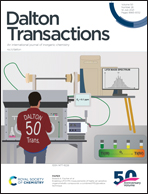Construction of MOF-shell porous materials and performance studies in the selective adsorption and separation of benzene pollutants†
Abstract
Metastable Cu2O is an attractive material for the architectural design of integrated nanomaterials. In this context, Cu2O was used as the sacrificial agent to form the core–shell structure of Cu2O@HKUST-1 by in situ growth technology. The MOFs with BOPs adsorption property were gathered together by a Cu2O etching method, and the hollow structure of the HKUST-1 shell material with fast BOP adsorption was successfully constructed. The adsorption experiments showed that the HKUST-1 shell has a good adsorption effect on nitrobenzene pollutants in wastewater. The investigation of various factors affecting the adsorption, thermodynamic and kinetic equations was carried out. The adsorption equilibrium was reached within 30 min, and the maximum adsorption capacity was 94.67 mg g−1 at 298 K. The adsorption capacity of nitrobenzene by the HKUST-1 shell is in good agreement with the Freundlich model and the second-order kinetic model. The possible mechanism of adsorption of nitrobenzene by the HKUST-1 shell was discussed. The experimental results suggested that Cu-BTC materials have potential applications for wastewater treatment involving benzene pollutants.



 Please wait while we load your content...
Please wait while we load your content...